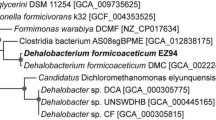Abstract
The phylogenetic relationships of 12 aerobic dichloromethane-degrading bacteria that implement different C1-assimilation pathways was determined based on 16S ribosomal RNA sequences and DNA–DNA hybridization data. The restricted facultative methylotroph “Methylophilus leisingerii” DM11 with the ribulose monophosphate pathway was found to belong to the genus Methylophilus cluster of the beta subclass of Proteobacteria. The facultative methylotroph Methylorhabdus multivorans DM13 was assigned to a separate branch of the alpha-2 group of Proteobacteria. Paracoccus methylutens DM12, which utilizes C1-compounds via the Calvin cycle, was found to belong to the alpha-3 group of Proteobacteria (more precisely, to the genus Paracoccus cluster). Thus, phylogenetic analysis confirmed the taxonomic status of these recently characterized bacteria. According to the degree of DNA homology, several novel strains of methylotrophic bacteria were divided into three genotypic groups within the alpha-2 group of the Proteobacteria. Genotypic group 1, comprising strains DM1, DM3, and DM5 through DM9, and genotypic group 3, comprising strain DM10, were phylogenetically close to the methylotrophic bacteria of the genus Methylopila, whereas genotypic group 2 (strain DM4) was close to bacteria of the genus Methylobacterium. The genotypic groups obviously represent distinct taxa of methylotrophic bacteria, whose status should be confirmed by phenotypic analysis.
Similar content being viewed by others
References
European Chlorinated Solvents Association: Plain Facts about Chlorinated Solvents, Brussels, 1995.
Line, D.E., Wu, S.A., Arnold, J.A., Jenning, G.D., and Rubin, A.R., Water Quality of Flush Runoff from 20 Industrial Sites, Water Environ. Res., 1997, vol. 5, no. 1, pp. 305–310.
Brunner, W., Staub, D., and Leisinger, Th., Bacterial Degradation of Dichloromethane, Appl. Environ. Microbiol., 1980, vol. 40, pp. 950–958.
La Pat-Polasko, L.T., McCarty, P.L., and Zehnder, A.J.B., Secondary Substrate Utilization of Methylene Chloride by an Isolated Strain of Pseudomonas sp., J. Appl. Environ. Microbiol., 1984, vol. 47, pp. 8825–8830.
Galli, R. and Leisinger, T., Specialized Bacterial Strains for the Removal of Dichloromethane from Industrial Waste, Conserv. Recycling, 1985, vol. 8, pp. 91–100.
Stucki, G., Galli, R., Ebersold, H.-R., and Leisinger, T., Dehalogenation of Dichloromethane by Cell Extract of Hyphomicrobium DM2, Arch. Microbiol, 1981, vol. 130, pp. 366–371.
Galli, R. and Leisinger, T., Plasmid Analysis and Cloning of the Dichloromethane Utilization Genes of Methylomicrobium sp. DM4, J. Gen. Microbiol., 1988, vol. 134, pp. 943–952.
Doronina, N.V., Braus-Stromeyer, S.A., Leisinger, T., and Trotsenko, Y.A., Isolation and Characterization of a New Facultatively Methylotrophic Bacterium: Description of Methylorhabdus multivorans gen. nov., sp. nov., Syst. Appl. Microbiol., 1995, vol. 18, pp. 92–98.
Doronina, N.V. and Trotsenko, Yu.A., Methylophilus leisingerii, a Novel Species of Restricted Facultatively Methylotrophic Bacteria, Mikrobiologiya, 1994, vol. 63, pp. 530–537.
Doronina, N.V., Trotsenko, Y.A., Krausova, V.I., and Suzina, N.E., Paracoccus methylutens sp. nov., a New Aerobic Facultatively Methylotrophic Bacterium Utilizing Dichloromethane, Syst. App. Microbiol., 1998, vol. 21, no. 2, pp. 230–236.
Marmur, J.A., A Procedure for the Isolation of Deoxyribonucleic Acid from Microorganisms, J. Mol. Biol., 1961, vol. 3, pp. 208–214.
Doronina, N.V., Govorukhina, N.I., Lysenko, A.M., and Trotsenko, Yu.A., Analysis of DNA–DNA Homology in Obligately Methylotrophic Bacteria, Mikrobiologiya, 1988, vol. 57, pp. 629–633.
Lane, D.E., 16S/23S rRNA Sequencing, Nucleic Acid Techniques in Bacterial Systematics, Stackebrandt, E. and Goodfellow, M., Eds., New York: Wiley, 1991, pp. 115–147.
Majdak, R.L., Cole, J.R., Parker, C.T., Garrity, J.M., Larsen, N., Li, B., Lilburn, T.G., McCaughey, M.J., Olsen, G.J., Overbeek, R., Pramanik, S., Schmidt, T.M., Tiedje, J.M., and Woese, C.R., A New Version of the RDP (Ribosomal Database Project), Nucleic Acids Res., 1999, vol. 27, pp. 171–173.
Jukes, T.H. and Cantor, C.R., Evolution of Protein Molecules, Mammalian Protein Metabolism, Munro, H.H., Ed., New York: Academic, 1969, pp. 21–132.
Van de Peer, Y. and DeWachter, R., TREECON for Windows: A Software Package for the Construction and Drawing of Evolutionary Trees for the Microsoft Windows Environment, Comput. Appl. Biosci., 1994, vol. 10, pp. 569–570.
Woese, C.R., Bacterial Evolution, Microbiol. Rev., 1987, vol. 51, pp. 221–271.
Doronina, N.V., Trotsenko, Y.A., Krausova, V.I., Boulygina, E.S., and Tourova, T.P., Methylopila capsulata gen. nov., sp. nov., a Novel Non-Pigmented Aerobic Facultatively Methylotrophic Bacterium, Int. J. Syst. Bacteriol., 1998, vol. 48, no. 4, pp. 1313–1321.
Stackebrandt, E. and Goebel, B.M., Taxonomic Note: A Place for DNA–DNA Reassociation and 16S rRNA Sequence Analysis in the Species Definition in Bacteriology, Int. J. Syst. Bacteriol., 1994, vol. 44, no. 4, pp. 846–849.
Wayne, L.G., Brenner, D.J., Colwell, R.R., Grimont, P.A.D., Kandler, O., Krichevsky, M.I., Moeere, L.H., Moeere, W.E.C., Murrey, R.G.E., Stackebrandt, E., Starr, M.P., and Trüper, H.G., Report of the Ad Hoc Committee on Reconciliation of Approaches to Bacterial Systematic, Int. J. Syst. Bacteriol., 1987, vol. 37, pp. 463–464.
Kohler-Staub, D., Hartmans, S., Galli, R., Suter, F., and Leisinger, Th., Evidence for Identical Dichloromethane Dehalogenases in Different Methylotrophic Bacteria, J. Gen. Microbiol., 1986, vol. 132, pp. 2837–2843.
Author information
Authors and Affiliations
Rights and permissions
About this article
Cite this article
Tourova, T.P., Kuznetsov, B.B., Doronina, N.V. et al. Phylogenetic Analysis of Dichloromethane-Utilizing Aerobic Methylotrophic Bacteria. Microbiology 70, 79–83 (2001). https://doi.org/10.1023/A:1004801106488
Issue Date:
DOI: https://doi.org/10.1023/A:1004801106488




